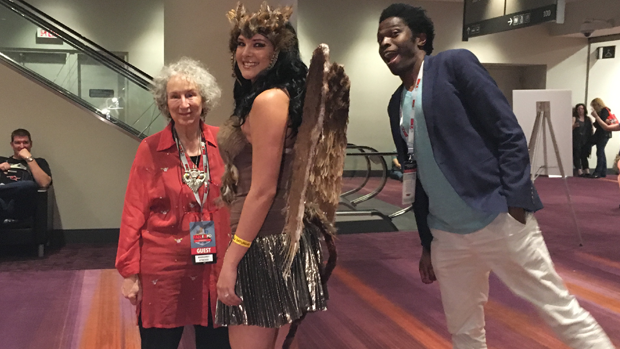As comic illustrator Johnnie Christmas answers his cell phone in Saskatoon to talk about Angel Catbird, his just-released graphic novel collaboration with Canadian literary icon Margaret Atwood, the book is sitting at the top of the New York Times bestseller list. He's in the Prairies for the Saskatoon Comic and Entertainment Expo, and his voice is already raspy from talking to fervent fans and fellow pros about the superhero project all weekend long. But while blown away by the amount of positive feedback, he hasn't run into anyone as devoted as an owl-feathered, cat-tailed cosplayer he and Atwood met at an Ontario convention earlier in the month.
"I have not seen anyone dressed up for this one, but I don't expect anyone to match that cosplayer in Toronto. She went all out," the Vancouver native says, clearly flattered that the just-debuted character he co-designed has already attracted a feral fan following. "She had contacts that looked like cat eyes--the whole thing. It was amazing."
While the first volume of the series was released through independent publishers Dark Horse Comics in early September, Christmas has been working on the project with Atwood since the spring of 2015. The Cat's Eye author had reached out to Canadian comics magnate Hope Nicholson about developing a story involving a scientist accidentally mutated into a cat/bird/human hybrid, and the inherent personality conflicts that come with that mix. After being put in touch with Christmas – a veteran indie comics artist whose resume includes Image Comics survival story Sheltered – the two creatives fired off a series of e-mails to each other to hash out the design for the whiskered, wide wing-spanned superhero.
"Margaret was really good with the collaborative element, because she would send enough detail to get things going, to inspire a creative burst. But not so much that it would bog me down," Christmas explains, noting that he was given loose suggestions rather than concrete demands. "'The eyelashes have to look like this, and fingernails like this...' there was none of that."
But while it was easy to come up with the sleek design for Angel Catbird, the superhero alter ego of DNA splicer Strig Feleedus, Atwood had to encourage Christmas to make fellow half-cat Cate Leone an object of animal desire for the protagonist. As he explains in the book's production notes, he's not often penciling a character's outwardly "primal appeal."
"A lot of the characters in the stories I've drawn are set in the real world, but with a heightened element. Sheltered was doomsday-preppers who thought the end of the world was coming," the artist elaborates, adding that Atwood's conceptual drawing of Leone in a furry halter top helped steer him in the right direction. "I'm not this cheesecake artist; I'm not going to draw sexy stuff for the sake of sexy stuff. I actually like real world people, things that sell sex appeal better through knowing the character."
At 70 pages, the first volume from Atwood, Christmas and colourist Tamra Bonvillain sets up plenty of intriguing character portraits. Feleedus is a nebbish, work-focused figure in its opening moments, but his transformation opens him to a primal world of possibilities. With his new powers, he learns to fly, sends out plenty of pheromones to Leone, and adapts to a newfound predatory bloodlust.
The book also introduces a rat-like villain named Dr. Muroid, and a society of cats that includes Count Catula, whom Christmas describes as an "old world gentleman vampire". The nearly-completed second volume, due in February, takes a gothic twist by heading to the latter, bushy-mustached bloodsucker's castle. By the time Christmas gets back to Vancouver, he'll hit his Main Street studio to start drawing the third and final entry.
While tapping into elements of fantasy and science fiction, one of Atwood's goals was to also give Angel Catbird's narrative a grounded conservationist angle. Among other things, it points to the high mortality rates of outdoor cats, and, using stats supplied by Nature Canada, uses a footer to explain that feral felines are responsible for the deaths of an estimated two million birds in Canada each year. Angel Catbird ultimately promotes the practice of keeping cats indoors.
From its quirky plot points, to its conscientious theme, to the fact that he'd be working with a brand new character, the uniqueness of Angel Catbird was a major part of the attraction for Christmas.
"Those early superhero comics, a lot of times they just weren't defined," he says. "No one knew what they were quite yet. With Superman, he was this strong guy, and he could fly. Batman wasn't quite yet Batman. Right now, they're very codified because you have 70-plus years of their stories being refined."
Christmas continues of this latest, chiseled-chest addition to the canon: "I liked the idea of getting in at the ground floor of this very unique concept, of creating this thing that would feel like those early comics. Where people are like, 'what is this?'"
Comic fans may just be getting to know Angel Catbird, but going by the early buzz and cosplay opportunities, the character is already bringing out something primal in people.


